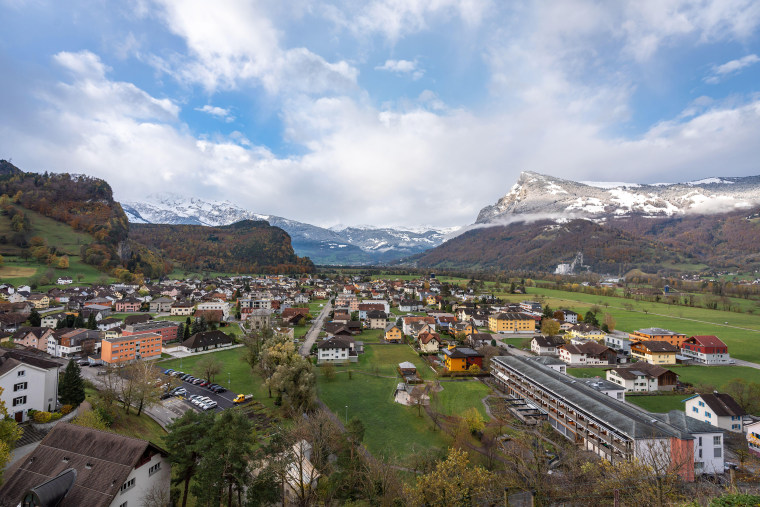The European Alps are an iconic, crescent-shaped mountain range associated with images of wintry peaks and snow-covered villages. But new research confirms a worrying trend about the winter-sports destination: The Alps are turning from white to green.
In a study published Thursday in the journal Science, researchers report that a process called “greening” is occurring over large swaths of the Alps. While this term is sometimes used to refer to making a space more environmentally friendly, in this case, it refers to an increase in plant growth and spread which can accelerate climate change.
Greening can potentially cause a few positive consequences, but the negative consequences outweigh these effects, said Sabine Rumpf, the study’s first author and a professor at the University of Basel in Switzerland.
This phenomenon is occurring across 77 percent of the European Alps above the tree line — the edge of alpine habitats where trees stop growing. An earlier estimate reported this was happening in just 56 percent of the region.
Rumpf and her colleagues also found that snow cover has declined significantly in 10 percent of the Alps. These figures are based on an analysis of 38 years of data. The scientists evaluated information captured by the Landsat Missions, a group of eight Earth-observing satellites that use remote sensors to collect data. Instead of looking at images, the team used this data to calculate the spread of snow cover and vegetation productivity.
While 10 percent may sound small, the potential impact is large. Beyond playing an important role in ecosystems, snow is essential for people as a source of drinking water. The Alps are the highest and most extensive mountain range entirely in Europe. Forty percent of Europe’s drinking water stems from this area. This is why the Alps are called the “water towers” of Europe, Rumpf said.
A reduction in snow does not mean there will be less drinking water available tomorrow, but it does suggest a concerning long-term trend, she explained.
One issue with climate change, Rumpf said, is that by now most people are aware of it but “the consequences of our actions are decoupled from our everyday life.” Most people do not see the results of the crisis immediately.
“We hear about it, we see numbers, but these facts can feel removed,” she said. “My hope is that these very striking effects — which are now actually visible from space — might be easier for people to grasp, rather than findings concerning how much carbon dioxide we have in the atmosphere.”
Carbon dioxide definitely plays a role. Mountain regions, which are hot spots for biodiversity, are warming about twice as fast as the global average. This warming drives greening and the subsequent increase in vegetation pushes the cycle forward. Taller and denser plant life in areas where this isn’t the norm can put alpine plant and animal communities at risk and release further greenhouse gases through the melting of permafrost.
Greening can also prevent snow cover, and less snow harms an area’s ability to reflect solar radiation — energy that comes to the Earth from the Sun. An inability to reflect this energy contributes to overall warming.
“Snow reflects about 90 percent of it back,” Rumpf said. “When we have less snow, we keep more of this energy.”
Alexander Winkler, a postdoctoral researcher at the Max Planck Institute for Biogeochemistry, was not a part of this research but also studies how climate change affects vegetation. Beyond greening, there is also browning — this is when plants die, something his research shows is happening in tropical regions. Beyond the Alps, greening is well-established in the Arctic, a reality some experts say should be viewed as a bellwether of global climate change.
“The vegetation trends are now well-known among the scientific community but are certainly underappreciated phenomena among the public,” he said.
When he speaks to people about greening as a response to carbon dioxide emissions and human-caused climate change, the response Winkler often gets is: “So that’s a good thing, right?”
Not necessarily, he said. While plants can absorb and store atmospheric carbon dioxide, which can help combat climate change, the other costs are severe.
Rumpf agrees. “It’s also important to remember that the carbon dioxide absorbed by plant biomass is not stored for eternity and taken out of the system,” she said. “It gets recycled and enters the system again. It’s not truly gone.”
Alpine plants, because of their smaller size, also play a much smaller role in the absorption of carbon dioxide overall.
While there are efforts underway to create protected areas of biodiversity in the Alps, Rumpf said, major action is needed to slow this trend. Overall, changes in precipitation driven by climate change are expected to reduce snow cover by up to 25 percent in the Alps, over the next 10 to 30 years.
“We can try to mitigate these effects on small scales, but if we don’t change the source of the problem it’s a rather feeble effort,” she said.
